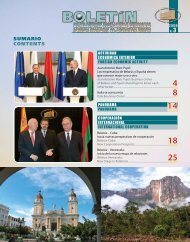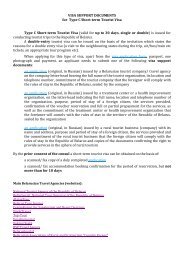Human Development Report 2013 - UNDP
Human Development Report 2013 - UNDP
Human Development Report 2013 - UNDP
You also want an ePaper? Increase the reach of your titles
YUMPU automatically turns print PDFs into web optimized ePapers that Google loves.
Not all countries havethe preconditions forcomplete demilitarization,but most have scope forsubstantial slowing intheir military spendingFIGURE 1.8Today the majority of security threats comenot from other countries but from insurgencies,terrorism and other civil conflicts. 62Conflicts in the post–Cold War era haveclaimed more than 5 million casualties, 95% ofthem civilians. 63In South Asia, for example, all nine countrieshave experienced internal conflict in the lasttwo decades, and the resulting casualties haveoutnumbered those from interstate conflicts. 64Moreover, since 2001, more of the conflictshave been in the poorer regions of those countriesthan elsewhere. 65In 2010, military spending worldwide forthe 104 countries with data available wasmore than $1.4 trillion, or 2.6% of worldGDP. Most of the spending was by veryhigh HDI countries. But as other countries’economies have grown, particularly mediumHDI countries, their military expenditureshave been increasing. Between 1990 and2010, military spending more than tripled inmedium HDI countries, while rising close to50% in low HDI countries and 22% in veryhigh HDI countries and falling almost 47%in high HDI countries. Nevertheless, in thethree HDI groups where total military expendituregrew, the increase was slower thanGDP growth. These aggregates hide considerablediversity. Europe and Central Asiasaw military spending decline 69% between1990 and 2010, while South Asia, East Asiaand the Pacific, and the Arab States saw it rise43%–388%. 66Although development is often accompaniedby a rise in military spending, this is not alwaysthe case (figure 1.8). The highest shares of militaryspending as a proportion of GDP are invery high and high HDI countries, but somevery high HDI countries have a share below 1%of GDP, among them Austria, Iceland, Irelandand Luxembourg.This is of particular significance for the risingcountries of the South. Costa Rica, for example,has not had an army since 1948. 67 It spendsnothing on the military and has thus been ableto earmark more funds for social programmesand social investments. 68 In 2009, it invested6.3% of GDP in education and 7% in health.Such choices contributed to its progress on theHDI from 0.621 in 1980 to 0.773 in 2012.Today, around 20 countries have small or noarmed forces. They tend to possess small territories,and many of them rely on external powersfor national security. Not all countries have thepreconditions for complete demilitarization,but most have scope for substantial slowingin their military spending. Particularly withrespect to internal conflicts, India has shownthat while policing may be more effective incurbing violence in the short term, redistributionand overall development are betterstrategies to prevent and contain civil unrest inthe medium term. 69<strong>Development</strong> is not always accompanied by a rise in military spendingMilitary spending, 2010 (% of GDP)1210864200.2 0.4 0.6 0.8 1.0HDI, 2012Low HDIMedium HDIHigh HDIVery high HDISource: Military expenditure, Stockholm International Peace Research Institute; HDI, HDRO calculations.* * *This analysis of the state of human developmentis positive and hopeful. Yet much workremains. Almost every country has challengesto overcome and opportunities for furtherprogress. Of particular concern is that somedeveloped countries, in response to the debtcrisis, are pursuing austerity policies that couldforeclose or reduce future choices and optionsfor people in the South.The only viable path to higher human developmentis through active investment inenhancing capabilities and enlarging opportunities.As the 1991 <strong>Human</strong> <strong>Development</strong> <strong>Report</strong>noted, “People who are healthier, confident,and skilled will be in a much better positionto cope with a fast-changing environment and40 | HUMAN DEVELOPMENT REPORT <strong>2013</strong>
















